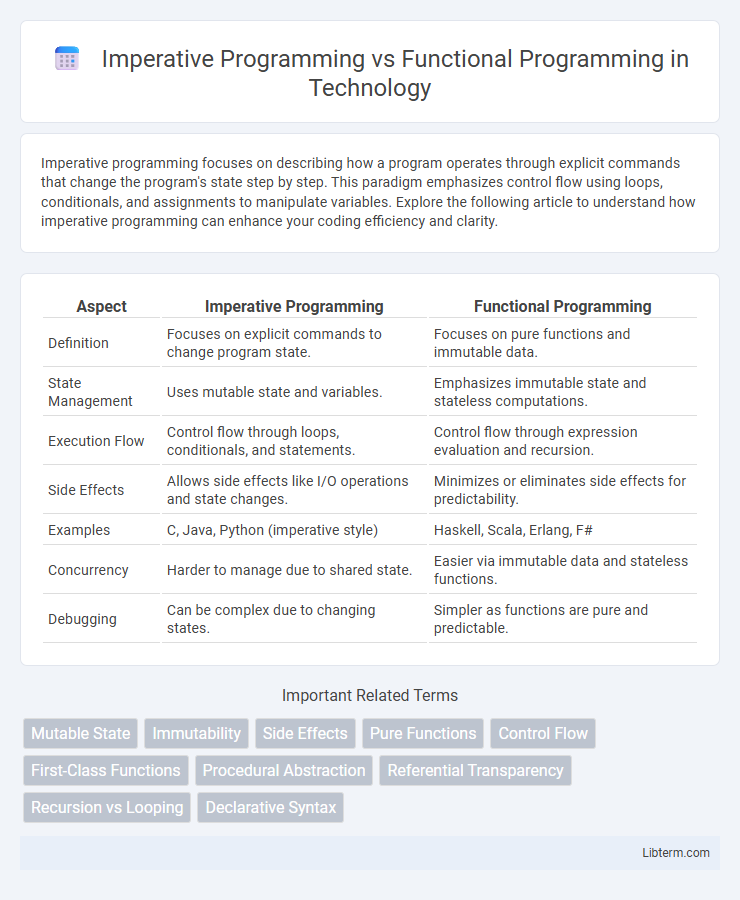Imperative programming focuses on describing how a program operates through explicit commands that change the program's state step by step. This paradigm emphasizes control flow using loops, conditionals, and assignments to manipulate variables. Explore the following article to understand how imperative programming can enhance your coding efficiency and clarity.
Table of Comparison
| Aspect | Imperative Programming | Functional Programming |
|---|---|---|
| Definition | Focuses on explicit commands to change program state. | Focuses on pure functions and immutable data. |
| State Management | Uses mutable state and variables. | Emphasizes immutable state and stateless computations. |
| Execution Flow | Control flow through loops, conditionals, and statements. | Control flow through expression evaluation and recursion. |
| Side Effects | Allows side effects like I/O operations and state changes. | Minimizes or eliminates side effects for predictability. |
| Examples | C, Java, Python (imperative style) | Haskell, Scala, Erlang, F# |
| Concurrency | Harder to manage due to shared state. | Easier via immutable data and stateless functions. |
| Debugging | Can be complex due to changing states. | Simpler as functions are pure and predictable. |
Overview of Imperative and Functional Programming
Imperative programming focuses on describing how a program operates through statements that change a program's state using variables, loops, and conditional statements, with languages like C, Java, and Python commonly exemplifying this paradigm. Functional programming emphasizes the evaluation of pure functions and avoids mutable state and side effects, promoting immutability and higher-order functions, as seen in languages such as Haskell, Scala, and Erlang. The imperative approach prioritizes step-by-step instructions and control flow, while functional programming centers on declarative expressions and mathematical function composition to achieve predictable and maintainable code.
Key Principles of Imperative Programming
Imperative programming relies on explicit statements that change a program's state through sequences of commands, emphasizing control flow with loops and conditionals. It focuses on how to achieve tasks by managing variables and mutable data, often using constructs like assignments and iterative processes. This approach contrasts with functional programming's stateless nature and declarative style, where immutable data and pure functions dominate.
Core Concepts in Functional Programming
Functional programming centers on pure functions, immutability, and first-class functions, emphasizing the avoidance of side effects to ensure predictability and testability. Core concepts include higher-order functions, which take other functions as arguments or return them, and recursion as a primary method for iteration instead of loops. The paradigm enhances code modularity, supports lazy evaluation, and facilitates easier reasoning about program behavior compared to imperative programming.
Syntax Differences Between Imperative and Functional Languages
Imperative programming relies on explicit statements that change a program's state through variables and control flow constructs like loops and conditionals, often resulting in verbose syntax with mutable data. Functional programming emphasizes expressions and immutability, using functions as first-class citizens and relying on recursion and higher-order functions instead of loops, leading to concise, declarative syntax. Languages like C and Java showcase imperative syntax with statements and assignments, while Haskell and Lisp demonstrate functional syntax characterized by nested expressions and function composition.
State Management and Side Effects
Imperative programming manages state through explicit variable manipulation and control flow, making side effects common and often necessary during program execution. Functional programming emphasizes immutable state and pure functions, which avoid side effects by returning new data instead of modifying existing variables. This paradigm shift enhances predictability and simplifies debugging by minimizing hidden state changes and promoting referential transparency.
Code Readability and Maintainability
Imperative programming emphasizes explicit step-by-step instructions, which can lead to complex and verbose code, making readability and maintenance challenging in large-scale projects. Functional programming promotes immutability and stateless functions, enhancing code clarity and reducing side effects for easier debugging and modification. The declarative nature of functional programming often results in more concise and modular code, improving both readability and long-term maintainability.
Performance Implications
Imperative programming often provides better performance in scenarios requiring direct manipulation of hardware and memory due to its mutable state and sequential execution model. Functional programming promotes immutability and stateless functions, which can introduce overhead from frequent memory allocation and garbage collection, potentially impacting runtime efficiency. However, functional languages benefit from advanced compiler optimizations, such as lazy evaluation and parallelism, which can mitigate performance drawbacks in specific computational tasks.
Popular Imperative and Functional Programming Languages
Popular imperative programming languages such as C, Java, and Python emphasize explicit state changes and sequential command execution, making them suitable for tasks requiring detailed step-by-step control. Functional programming languages like Haskell, Scala, and Erlang prioritize immutable data and first-class functions, facilitating powerful abstractions and parallel processing capabilities. The choice between imperative and functional languages often depends on the problem domain, with imperative languages dominating system-level and procedural programming, while functional languages excel in concurrent and declarative programming scenarios.
Real-World Use Cases and Applications
Imperative programming excels in real-world applications requiring explicit state management, such as system software, game development, and embedded systems, where step-by-step control and mutable data are critical. Functional programming suits data transformation tasks, concurrent systems, and financial modeling due to its emphasis on immutability, stateless functions, and easier parallelization, enhancing code reliability and maintainability. Industries like telecommunications, big data processing, and artificial intelligence increasingly leverage functional paradigms for scalable, predictable solutions.
Choosing Between Imperative and Functional Programming
Choosing between imperative and functional programming depends on the project's requirements, team expertise, and software maintainability goals. Imperative programming offers straightforward control flow and state management, making it suitable for performance-critical applications and situations demanding fine-grained hardware interaction. Functional programming promotes immutability and stateless design, enhancing code predictability, parallel processing, and reducing side effects, which benefits complex, concurrent, or large-scale distributed systems.
Imperative Programming Infographic

 libterm.com
libterm.com